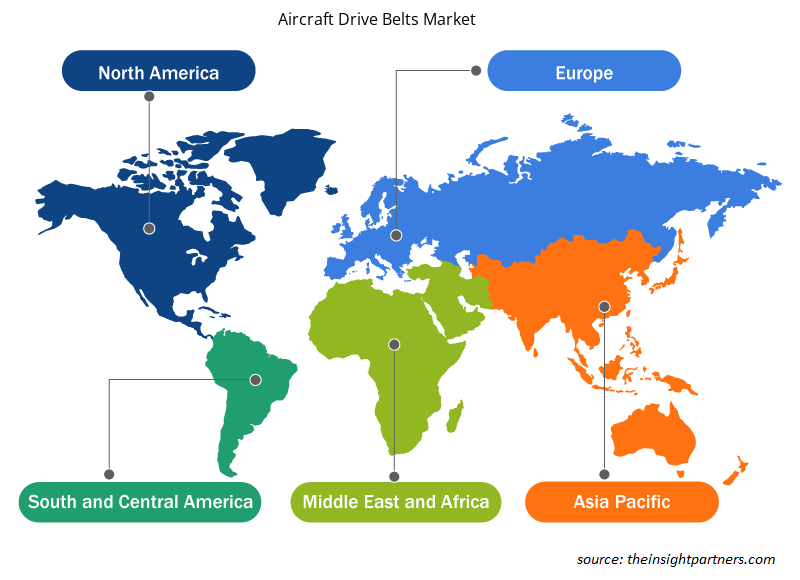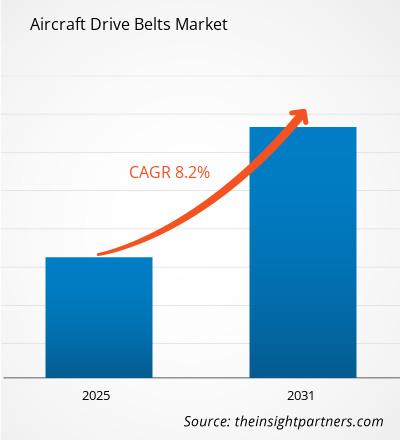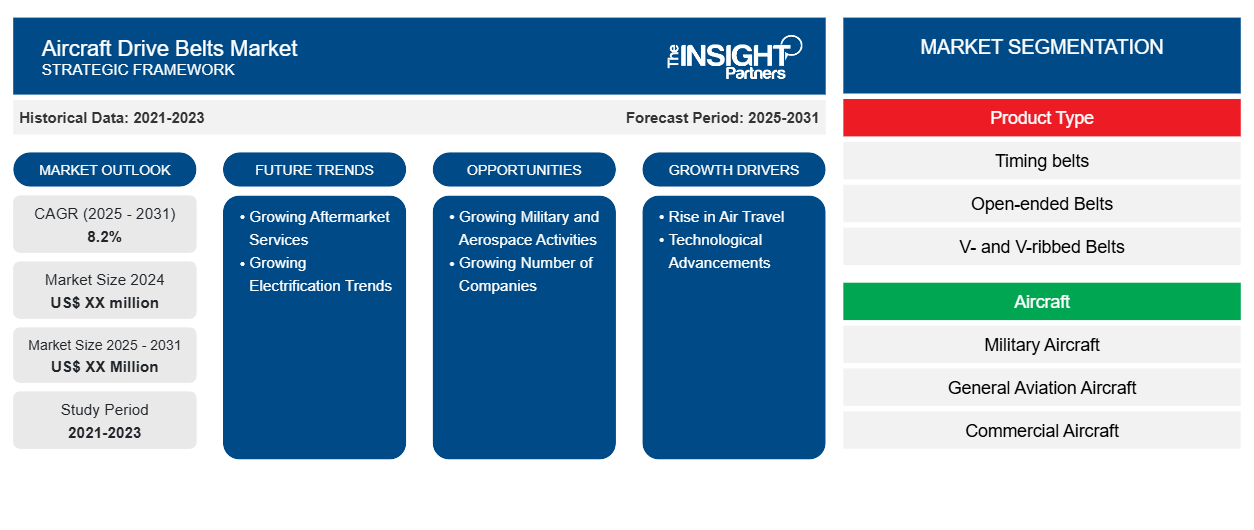Si prevede che il mercato delle cinghie di trasmissione per aeromobili registrerà un CAGR dell'8,2% dal 2023 al 2031, con una dimensione di mercato in espansione da XX milioni di dollari nel 2023 a XX milioni di dollari entro il 2031.
Il report è segmentato per tipo di prodotto (cinghie di distribuzione, cinghie aperte, cinghie trapezoidali e cinghie scanalate); aeromobili (aeromobili militari, aeromobili per l'aviazione generale, aeromobili commerciali). L'analisi globale è ulteriormente suddivisa a livello regionale e nei principali paesi. Il report offre il valore in USD per l'analisi e i segmenti di cui sopra.
Scopo del rapporto
Il report Aircraft Drive Belts Market di The Insight Partners mira a descrivere il panorama attuale e la crescita futura, i principali fattori trainanti, le sfide e le opportunità. Ciò fornirà spunti a vari stakeholder aziendali, come:
- Fornitori/produttori di tecnologia: per comprendere le dinamiche di mercato in evoluzione e conoscere le potenziali opportunità di crescita, consentendo loro di prendere decisioni strategiche informate.
- Investitori: condurre un'analisi completa delle tendenze in merito al tasso di crescita del mercato, alle proiezioni finanziarie del mercato e alle opportunità esistenti lungo la catena del valore.
- Enti di regolamentazione: regolamentano le politiche e le attività di controllo sul mercato allo scopo di ridurre al minimo gli abusi, preservare la fiducia degli investitori e sostenere l'integrità e la stabilità del mercato.
Segmentazione del mercato delle cinghie di trasmissione per aeromobili
Tipo di prodotto
- Cinghie di distribuzione
- Cinture aperte
- Cinghie trapezoidali e cinghie trapezoidali scanalate
Aereo
- Aerei militari
- Aeromobili dell'aviazione generale
- Aereo commerciale
Personalizza questo report in base alle tue esigenze
Riceverai la personalizzazione gratuita di qualsiasi report, comprese parti di questo report, o analisi a livello nazionale, pacchetto dati Excel, oltre a usufruire di grandi offerte e sconti per start-up e università
-
Scopri le principali tendenze di mercato in questo rapporto.Questo campione GRATUITO includerà analisi di dati che spaziano dalle tendenze di mercato alle stime e alle previsioni.
Fattori trainanti della crescita del mercato delle cinghie di trasmissione per aeromobili
- Aumento dei viaggi aerei: l'aumento dei viaggi aerei in tutto il mondo continua a incrementare la domanda di nuovi aeromobili, il che aumenta di conseguenza la necessità di freni di azionamento di qualità premium per aeromobili. L'aumento del numero di passeggeri e l'espansione delle compagnie aeree low cost stanno ulteriormente aiutando l'industria manifatturiera degli aeromobili ad aumentare il suo tasso di crescita.
- Progressi tecnologici: l'evoluzione di nuovi materiali riduce il peso, migliorando la sicurezza e l'efficienza delle operazioni di volo, il che a sua volta stimola la crescita di questo mercato.
Tendenze future del mercato delle cinghie di trasmissione per aeromobili
- Crescita dei servizi post-vendita: il crescente sviluppo dei servizi post-vendita e la crescente disponibilità di componenti aeronautici avanzati, essenziali per le attività aeronautiche, stanno stimolando la crescita del mercato delle cinghie di trasmissione per aeromobili.
- Crescenti tendenze all'elettrificazione: il settore aerospaziale si sta muovendo lentamente verso l'elettrificazione e si affida all'azionamento elettrico anziché ai sistemi idraulici convenzionali, che rappresentano una delle principali tendenze del mercato.
Opportunità di mercato per le cinghie di trasmissione degli aeromobili
- Crescita delle attività militari e aerospaziali: le crescenti spese per la difesa e la crescente attenzione del governo all'acquisto di tecnologie avanzate per contrastare le situazioni di guerra moderna stanno agendo come un importante motore per il mercato.
- Numero crescente di aziende: il crescente numero di aziende che offrono cinghie di trasmissione per aeromobili in tutto il mondo sta anche aumentando l'intensa concorrenza che si prevede guiderà la crescita del mercato nel periodo di previsione.
Approfondimenti regionali sul mercato delle cinghie di trasmissione per aeromobili
Le tendenze regionali e i fattori che influenzano il mercato delle cinghie di trasmissione per aeromobili durante il periodo di previsione sono stati ampiamente spiegati dagli analisti di Insight Partners. Questa sezione discute anche i segmenti e la geografia del mercato delle cinghie di trasmissione per aeromobili in Nord America, Europa, Asia Pacifico, Medio Oriente e Africa e America meridionale e centrale.

- Ottieni i dati specifici regionali per il mercato delle cinghie di trasmissione per aeromobili
Ambito del rapporto di mercato sulle cinghie di trasmissione per aeromobili
| Attributo del report | Dettagli |
|---|---|
| Dimensioni del mercato nel 2023 | XX milioni di dollari USA |
| Dimensioni del mercato entro il 2031 | XX milioni di dollari USA |
| CAGR globale (2023-2031) | 8,2% |
| Dati storici | 2021-2022 |
| Periodo di previsione | 2024-2031 |
| Segmenti coperti |
Per tipo di prodotto
|
| Regioni e Paesi coperti |
America del Nord
|
| Leader di mercato e profili aziendali chiave |
|
Densità degli attori del mercato delle cinghie di trasmissione per aeromobili: comprendere il suo impatto sulle dinamiche aziendali
Il mercato delle cinghie di trasmissione per aeromobili sta crescendo rapidamente, spinto dalla crescente domanda degli utenti finali dovuta a fattori quali l'evoluzione delle preferenze dei consumatori, i progressi tecnologici e una maggiore consapevolezza dei vantaggi del prodotto. Con l'aumento della domanda, le aziende stanno ampliando le loro offerte, innovando per soddisfare le esigenze dei consumatori e capitalizzando sulle tendenze emergenti, il che alimenta ulteriormente la crescita del mercato.
La densità degli operatori di mercato si riferisce alla distribuzione di aziende o società che operano in un particolare mercato o settore. Indica quanti concorrenti (operatori di mercato) sono presenti in un dato spazio di mercato in relazione alle sue dimensioni o al valore di mercato totale.
Le principali aziende che operano nel mercato delle cinghie di trasmissione per aeromobili sono:
- Sicurezza
- Aerocare International Ltd
- Cinture per aeromobili, Inc. (ABI).
- Continentale AG
- Azienda produttrice di aeromobili Davis.
Disclaimer : le aziende elencate sopra non sono classificate secondo un ordine particolare.

- Ottieni una panoramica dei principali attori del mercato delle cinghie di trasmissione per aeromobili
Punti chiave di vendita
- Copertura completa: il rapporto copre in modo completo l'analisi di prodotti, servizi, tipologie e utenti finali del mercato delle cinghie di trasmissione per aeromobili, fornendo una panoramica olistica.
- Analisi degli esperti: il rapporto è compilato sulla base della conoscenza approfondita di esperti e analisti del settore.
- Informazioni aggiornate: il rapporto garantisce la pertinenza aziendale grazie alla copertura di informazioni recenti e tendenze nei dati.
- Opzioni di personalizzazione: questo report può essere personalizzato per soddisfare le esigenze specifiche del cliente e adattarsi in modo appropriato alle strategie aziendali.
Il rapporto di ricerca sul mercato delle cinghie di trasmissione per aeromobili può, quindi, aiutare a guidare il percorso di decodifica e comprensione dello scenario del settore e delle prospettive di crescita. Sebbene possano esserci alcune preoccupazioni valide, i vantaggi complessivi di questo rapporto tendono a superare gli svantaggi.
- Analisi storica (2 anni), anno base, previsione (7 anni) con CAGR
- Analisi PEST e SWOT
- Valore/volume delle dimensioni del mercato - Globale, Regionale, Nazionale
- Industria e panorama competitivo
- Set di dati Excel
Report recenti
Testimonianze
Motivo dell'acquisto
- Processo decisionale informato
- Comprensione delle dinamiche di mercato
- Analisi competitiva
- Analisi dei clienti
- Previsioni di mercato
- Mitigazione del rischio
- Pianificazione strategica
- Giustificazione degli investimenti
- Identificazione dei mercati emergenti
- Miglioramento delle strategie di marketing
- Aumento dell'efficienza operativa
- Allineamento alle tendenze normative























 Ottieni un campione gratuito per - Mercato delle cinghie di trasmissione per aeromobili
Ottieni un campione gratuito per - Mercato delle cinghie di trasmissione per aeromobili